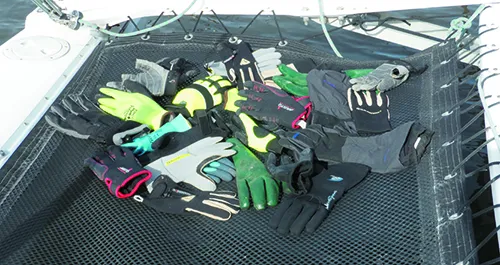Every ball player has a favorite glove. A deck shoe that sticks to wet gelcoat is highly prized. And when time comes to hoist the main, I reach for my favorite sailing gloves. They’ll come off again if the breeze is light and day is hot, but as soon as whitecaps appear, they go back on, delivering better grip and protecting aging tendons from bruising. Some sailors prefer the dexterity of bare hands and pride themselves on their calluses. Some say they can’t work with gloves on. But when the mercury drops and fingers become stiff, we all reach for gloves. And, of course, the best time to save money on cold-weather gloves is when spring is in the air.
I often hear “I can’t work in gloves.” I once felt that way. Then I spent years working in refineries, where gloves were required to prevent chemical exposures and burns. I climbed ice in sub-zero conditions, tying knots and clipping carabiners. As a result of practice, I can do most anything in gloves, short of the finest mechanical work, by choosing the right glove and thinking about how to do the job. Although I have my favorites, I can sail a boat perfectly well in any of the gloves in this review, handling lines and clipping tethers. I might have to pull them off to work a small soft shackle or loosen a jammed knot, but that is about it.
What We Tested
This season we looked at a variety of ski, dive, sailing, and industrial gloves. Practical Sailor reviewed winter gloves in April 2002 and November 2008, and many of those products are still available. We always encourage readers to pore over the PS archives. At the same time, there far too many new products keep up with.
Instead of diving into another exhaustive market review, we decided to build on what we have done before and the experience we have gained since, breaking gloves into functional categories, and at the same time, reviewing a few old and new products that have caught our eye and work for us.
Observations.
As our multi-season test program revealed, no glove serves all purposes. The best gloves for immersion (thick neoprene) are clumsy, uncomfortable, and don’t wear particularly well. Free-finger sailing gloves aren’t warm. Insulated ski gloves (and helm-specific gloves that resemble them) are comfortable at the wheel but clumsy and slow drying.
Waterproof shells are quick drying but the shell and liner combination can be cumbersome to quickly remove. Some gloves lack gauntlets, heavily coated gloves are stiff and clumsy, and thinner gloves are less durable. And sooner or later, even that mythical waterproof, breathable, dexterous glove will get wet, so you need spares.
Most likely, you’re going want multiple pairs, both for different tasks and to ensure that a pair is always dry. We keep several pairs of waterproof work gloves on the boat year round and add several pairs of ski gloves for the winter. Somebody is bound to get cold fingers.
Waterproof Element. Gloves that use a waterproof inserts instead of a waterproof shell are not as warm because the water penetrates some of the insulation. An insert is considerably cheaper and in the case of a work glove, better protected from penetration and wear. You can usually feel an insert as a crinkly layer when you pull the glove on. Depending on how it is attached to the shell, a separate liner can also shift when you remove a damp hand, making it difficult to put the glove back on. A three-layer Gore-Tex shell or coated glove is warmer.
Three-Season Gloves. For racers and active sailors, this is the most useful category, even in the depths of winter. But they are not really winter gloves. Featuring a 2 mm neoprene body and finger and palm facings like those on summer sailing gloves, they’re perfect for dinghy sailors in cold water areas and shoulder seasons. Advantages are good grip and outstanding dexterity. The Achilles’ heel of this class is the lack of insulation in the palm and finger facings. They are not waterproof and as soon as the palm gets wet, they are only a little warmer than heavy-duty three finger summer sailing gloves. Heat packs help.
Coated Gloves
Winter Gloves
| BRAND | MODEL | WATERPROOFING | WARMTH DRY | WARMTH WET | GRIP DRY | GRIP WET | PRICE |
|---|---|---|---|---|---|---|---|
| NEOSPORT | Five finger 5mm | Neoprene | Excellent | Excellent | Excellent | Good | 29 |
| ZIHK | Superwarm | Neoprene | Very good | Very good | Excellent | Good | 85 |
| NEOPRENE THREE-SEASON | |||||||
| HENDERSON | Tropic gloves | Neoprene Black | Fair | Poor | Good | Fair | 25 |
| GILL | 3-Season glove | All neophrene | Good | Fair | Very good | Good | 38 |
| MUSTO | Performance winter | All neophrene | Very good | Good | Very good | Good | 50 |
| SKI-STYLE GLOVES | |||||||
| VARIOUS BRANDS | Various | Gore-Tex insert | Excellent | Good | Good | Good | $45- $150 |
| MODULAR SHELLS | |||||||
| OUTDOOR RESEARCH | MGS | Gore-Tex shell | Excellent | Good | Very good | Good | 165 |
| ARC'TERYX | Beta AR Fore-Tex | Gore-Tex shell | Excellent | Good | Very good | Good | 145 |
| PATAGONIA | Stretch triolet | Gore-Tex shell | Excellent | Good | Very good | Good | 125 |
| COATED WORK | |||||||
| SHOWA ATLAS | Vinyl Love | PVC coating | Very good | Fair | Excellent | Good | 12 |
| KINCO | Hydroflecto 1786P | Latex coating | Very good | Very good | Excellent | Good | 12 |
| OTHER WORK | |||||||
| MAJESTIC | 2145HYH Winterhawk | Insert | Very good | Fair | Good | Fair | 12 |
Available both in gauntlet (Vinylove 460) and double coated (Hydroflector 1786P) styles, coated gloves are 100-percent waterproof, grip well, are inexpensive, and reasonably durable. Because they do not breath, they will get clammy within a few hours, there’s no way around it.


Thick Neoprene Gloves
Like coated gloves, your hands will get clammy. On the other hand, your hands will stay warm, no matter how wet the conditions. They are also tops for immersion, so if you carry a wetsuit or drysuit for entering the water in frigid conditions, you need a pair of these to complete the outfit, along with boots and a neoprene dive hood.
What about MOB situations or working in icy bilge water? We’ve reported on drysuits and immersion suits, but often the first thing to go is grip. A swimmer is thrown a line, but he simply can’t grasp it. Just a few minutes in icy water can paralyze your fingers.
To test warmth, we went swimming in 32F water (in a drysuit, of course). We hardly felt the cold when wearing the Neosport, Zihk, or Hydroflector gloves. Thinner, three-season gloves provided reasonable protection and much better dexterity, at least for a while. The Vinylove was icy cold as soon as the water came in the gauntlet. You will lose grip strength with any glove if your forearms get cold.
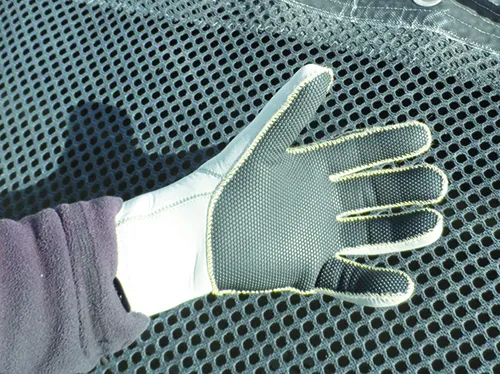
1. The Zhik Super warm is indeed warm. It had good grip and resisted wear.
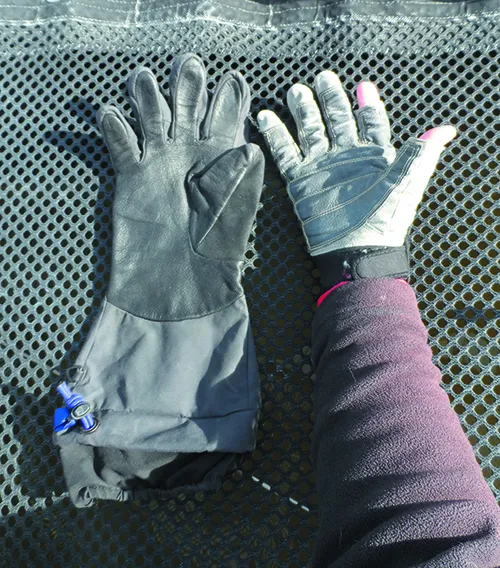
2. For chilly days, sailing gloves under a Gore-Tex and leather shell can be a winning combination. Just shed the big glove when you need finger dexterity.
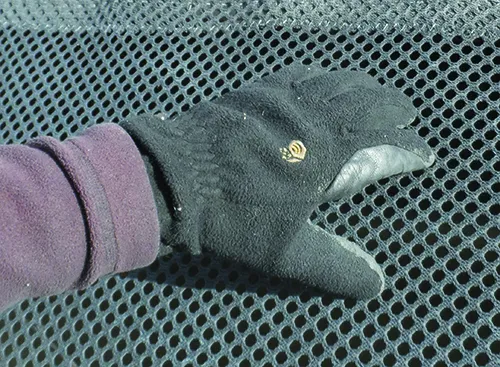
3. Technical editor Drew Frye’s old favorite was a Mountain Hardware Windblocker climbing glove, made of fleece and Pittards leather climbing glove
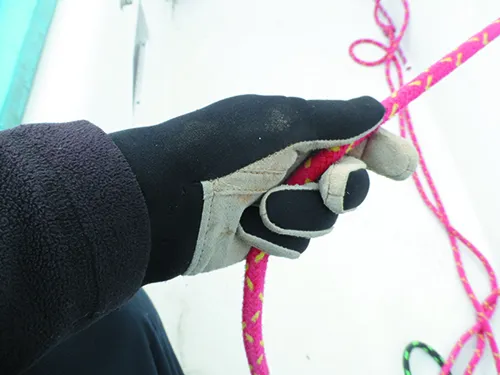
4. Henderson wetsuit gloves allowed excellent dexterity, but got wet easily and were never warm.
Three-Season Gloves
Most of these came from dinghy racing, and we learned about them while beach cat sailing youth. Depending on how warm your hands stay and how actively you sail, they may be enough.
Musto Winter Glove
Relatively warm for this category (meaning not all that warm), they had a good fit at the fingertips, promoting good line handling. A thin layer of grip material on the palm and fingers began to fail within a few days, but this proved to be superficial and the underlying layer proved quite tough. We used them hard as our main glove through the winter, and plan to use them for many more seasons.
Bottom line: Recommended for active sailors.
Gill three-season
The most popular glove out there, we found the fingers a bit tight and too long, reducing warmth. This may well be a personal fit thing and they are clearly popular. They’ve proven reasonably durable in hard use, lasting many seasons.
Bottom line: Recommended for active sailors.
Gore-Tex Over Shells
The advantages of a removable shell are that you have both the thin, dexterous under glove available for trimming sheets, tying knots, and working with instruments, and a wind and waterproof outer layer for while on watch or at the helm. Climbers and mountaineers appreciate the faster drying of such a system; insulated ski gloves become progressively more sodden each day, but liners and shells can dry in a few hours.
On the other hand, the fit between the shell and liner is critical; the shell likes to pull the liner off when you remove your hand unless it is secured at the wrist. Often a single glove is simpler to deal with. The liner also tends to get wet while in use without the shell, so when you put the liner back on, the combination is still wet.
We’re constantly mixing and matching the shell/liner combinations for different sports. On the boat, the liner is often a three-finger sailing glove; you preserve superior line handling, although the insulation is less.
We’ve also worn a variety of leather-faced fleece gloves and three-season sailing gloves as liners. The main requirements of a liner is that it is secured to the hand by a wrist band so that the shell can be quickly removed. Modern liners will have a conductive material on finger tips that will work with touch screens.
Patagonia Stretch Triolet
These have been in our rotation for 25 years, climbing ice in New Hampshire and the Tetons, and covering sailing gloves in the winter. After years of use, they leak a little, but somehow the Pittards leather palm and fingers have endured.
Bottom line: No longer available, we miss this design. Fortunately there are some (pricey) substitutes.

1. The Winter Hawk is warm and waterproof, but the linter gets sticky when wet, making it harder to don and doff.
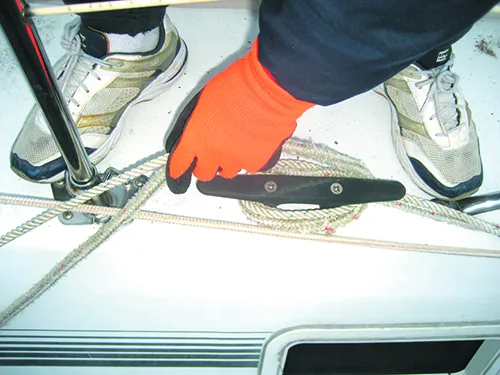
2. Freezer gloves are good for handling docklines, but get soaked easily and don’t block the wind.
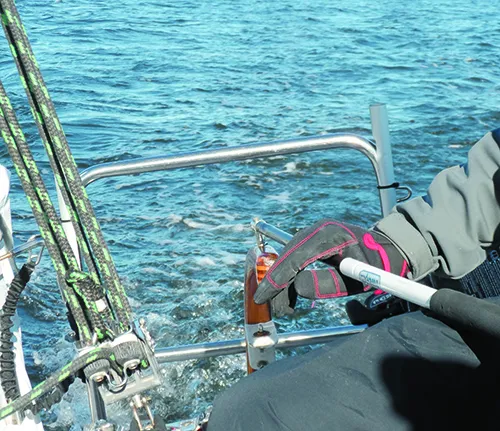
3. The fingers on Musto gloves were stiff initially, but eventually broke in and became our winter favorites.
Arc’teryx Beta AR Gore-Tex
Similar to the Stretch Triolet, these gloves served us well for three years. Constructed from three layers of Gore-Tex with a leather palm, these are also discontinued, through we still see them on eBay.
Bottom line: Arc’teryx has sadly discontinued its shell models. The closest we could find were the MGS (below) and a fishing glove system, the Simms ProDry glove plus liner (www.simmsfishing.com), which we hope to review in a future report.
Outdoor Research Modular Glove System (MGS)
A soldier deployed in cold areas needs a warm glove for protection and to preserve dexterity, and must be able to quickly change to a thinner tactical combat glove, without wasting time.
Pioneered by U.S. military special forces, the glove system includes a Gore-Tex/leather shell, similar to the above-mentioned shells, which can be combined with variety of liners from summer weight to fully insulated. We’ve inspected these, but not tested them on the water. They’re ruggedly made but carry a steep price tag (about $360). Inserts run from $70 to $220.
Bottom line: Pricey and perhaps too fiddly, but Recommended for those that like to try new things. Also look at the Simms ProDry glove system.
Ski Gloves
In prior reviews, insulated ski-style gloves from Gill and other high end ski gloves have performed very well. We’ve worn all types, from high end to lesser, and so long as they are fundamentally waterproof and have a tough material on the palm and fingers, we’ve been pretty happy with them. We’d rather have multiple dry pairs of mid-level gloves than one pair upon which we stake all the marbles. Sooner or later, we take them off to do something or drop them in a puddle and they’re wet for the rest of the day.
Line handling can be a weakness. Even when the grip is first rate, they are clumsy for changing a line on a winch. We’ve worn gloves with touch screen compatible tips, but they’re too fat to really work. We get frustrated and take them off—thus the appeal of a touch-ready liner and shell system.
Bottom line: Nothing beats a pair of dry ski gloves for all-day winter comfort at the helm.
Work Gloves
There has been an explosion in mechanic’s gloves over the past 10 years. Most are focused on high dexterity or protection of hands from vibration or cuts, but insulated and waterproof versions are also available.
Majestic Waterproof Insulated
We’ve used uninsulated versions of this glove at work and around the yard for decades, and they have proven durable and dextrous, so we decided to give the waterproof winter version a try. They stayed waterproof for a season of hard use. The grip on rope is not as good as we would like, about like that of non-sticky sailing gloves. The real disappointment was that they were awkward to pull on and off once they got slightly damp; the liner stuck to the fingers, pulled out part way, and was annoying to push back in. $11.
Bottom line: We didn’t like them around the yard, even less so on the boat.
Puffy gloves are warm but you can’t do anything. I’ve used the greatest super-warm gloves ice climbing in the New Hampshire winter. Sub-zero temperatures and running water are a real test. They were warm, dry, impeccably made… and felt like boxing gloves. I could swing the ice axes fine, but tying knots and clipping carabiners was unacceptably clumsy when clinging to an axe with one hand and balancing on crampon points.
I quickly converted to leather-faced windblocker fleece gloves under the Patagonia Stretch Triolet shells described in this review. To that system I added disposable hand warmer packs on sub-zero days, which lasted 8-12 hours as long as they were kept in the oxygen-depleted environment of a Gore-Tex glove. (Note: they really do NOT work inside a knit glove or sailing glove. The glove does not retain the heat and they burn out in a few hours because of excessive oxygen availability.)
This combination provided superior dexterity and warm fingers during 10 days of climbing that were constantly below zero, and really cold in the mornings and on the summits.
Like sailing, I was constantly handling ropes, tying knots, and clipping carabiners, and with a few hundred feet of air under your feet, dexteritymatters. On warmer days (above zero) I would climb with just the liners and the heat packs. You can buy a lot of hand warmers for the price of the ultimate glove.
We’re not fond of hand warmers for jackets (one more layer provides more comfort) or shoes (they interfere with the fit and can become too hot).
Please see “Hand Warmers,” Practical Sailor, April 2003 for a detailed review.
HotHands Hand Warmers. About $0.70/pair if you buy a box.
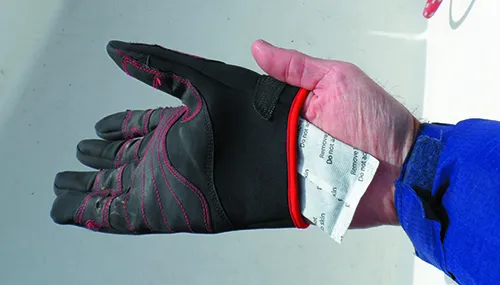
For maximum warmth, hand warmers go on the palm.
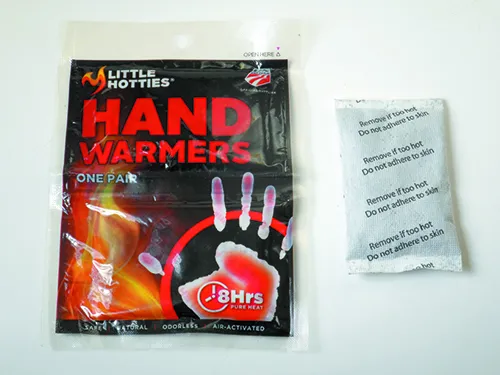
Hand warmers can allow thinner gloves to work in colder temperatures so long as the glove is wind-proof.
Neoprene Gloves
Made of wetsuit material, these often claim to be waterproof, but they eventually leak. However, like a wetsuit, it doesn’t really matter, since they are still warm when they are wet. In fact, if they don’t leak they will fill with sweat anyway, since there is zero breathability. The downsides are that if the materials is thick enough to insulate, bending the fingers is difficult, and like a wetsuit, if they are tight enough control water movement, they aren’t that comfortable for long periods. And you will get pruney if you wear them day-after-day.
Neosport Glove 5mm
A bit thicker than the Zhik Superwarm (5mm vs. 3mm) the Neosports are both slightly less dexterous and warmer. We wore these gloves for a six-hour drysuit test in 32F water, where they performed admirably, so they deliver all the warmth I will ever need.
I’ve worn them on numerous freezing rain kind of days, where they are the only thing that will absolutely keep you warm. On the down side, the palms and fingers have only a few rubber dots for grip and they don’t wear well when you are handling sheets. $24.
Bottom line: Recommended for immersion in cold water, but not durable enough for much sailing.
Zihk Super Warm
The Superwarm glove is a complete wrapping of 3mm neoprene, unlike most three-season gloves, which use synthetic leather on the palm and fingers.
To this they added a layer of high-grip textured polyurethane on the palm and fingers, something like the face of a ping-pong paddle, only better. It is glued and edge-sewn with Kevlar thread to the palms and fingers, providing considerable durability. The idea was to duplicate the warmth of dive gloves with a hard-wearing palm and fingers.
The warmth is there, but dexterity is reduced. Zihk suggests wearing another glove over them for heavy duty sheet handling, but that seemed unnecessary to us—the polyurethane facing is sturdy. Sizing runs small, even for neoprene gloves; consider going up a size. $59.
Bottom Line: Recommended for frostbiting and general use in cold, wet conditions.
Coated Gloves
Practically speaking, coated gloves are pretty much the only gloves that absolutely will not leak… until you get water in the cuff. Some people like them at the helm, and for long turns in rainy weather because they won’t leak. They are also handy for handling wet dock lines and anchor rode, if you want to save wear and tear on your fancy gloves. Coated gloves wear rapidly if ropes are allowed to slide under high load; you’re better off with thick leather when actively trimming sheets.
]
Showa Atlas Vinylove 460
A coated vinyl work glove with a thermal lining. Several coated glove manufacturers make similar insulated versions described as snow blower gloves. They are non-stretch and the fit is sloppy, so we find them awkward for anything but handing docklines or holding the helm. They can be slow to dry, but they’re warm and absolutely waterproof. $12.
Bottom line: Recommended. Every boat should have at least one pair.
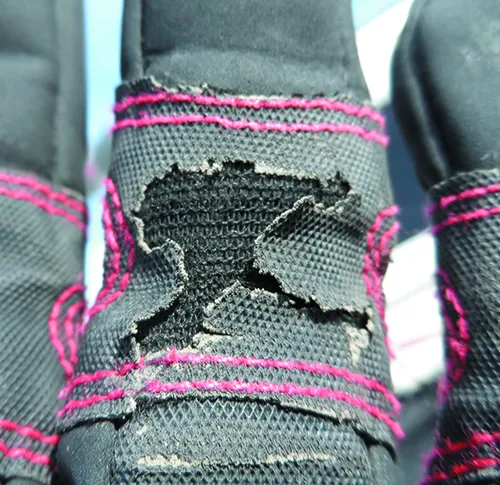
Kinco HydroFlector 1786P
A double-coated insulated work glove, these quickly became our all-time favorite winter paddling gloves, and we’ve used many. We use them on wet days when our three-season gloves got too cold.
A thin coating on the backs makes them waterproof without stiffness. A second coating on the palm provides grip and durability. Fleece insulation makes them warm even with your hand in ice water, and a snug cuff keeps the water out in most conditions. The only time water got inside was in our icy water immersion test, and it took several minutes. Like a wetsuit glove, the water warmed after a while in place.
The grip is a little too good for sail handling; lines won’t slide through your fingers. But with practice, we could sail with them even in sporty conditions, trimming and tacking swiftly. They run quite large, so order one size smaller than usual for good dexterity.
Bottom line: Recommended. If you don’t like them on the boat you’ll like them for something.
Conclusions
We’ll never have one favorite for all seasons. There are just too many variables. We like three-finger sailing gloves down to 55F; I guess we’re warm blooded and active. We like the Musto Winter glove down to 40F; it’s a true three-season glove that actually kept our fingers warm while allowing fast rope handling. In both cases, they work because we dress warmly, which keeps our hands warm.
Except for frequent screen use, the shells were kind of a bust for sailing. They worked, but we’d rather just switch between sailing gloves and warmer gloves.
The double-coated gloves were a pleasant surprise. They’re just plain luxurious for cold weather paddling.
We’ll always keep some mid-range ski gloves on the boat so we always have a dry pair and something to offer guests who miscalculated the conditions. We like coated work gloves for handling wet docklines and anchor rode; they dry fast and save wear on fancy gloves.
Our favorite will always depend on the temperature, whether it is wet or dry, and the kind of sailing we’re doing—fast or slow.
Arcteryx, www.arcteryx.com
Neosport, www.neosport.com
Henderson,
www.hendersonusa.com
Gill, www.gillmarine.com
Kinco, www.kinco.com
Musto, www.musto.com
outdoor research,
www.outdoorresearch.com
Patagonia, www.patagonia.com
Showa, www.showagloves.com
Zhik, www.zhik.com






























